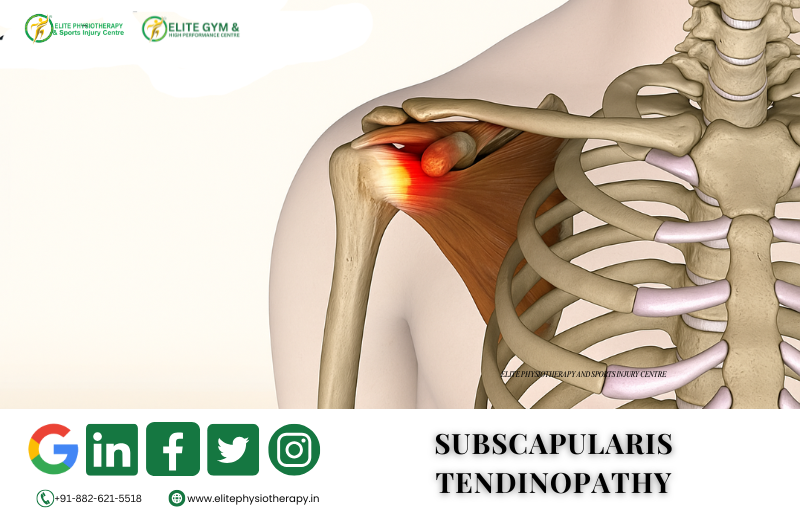Skip to content

What is Subscapularis Tendinopathy?
- The major internal rotator of the shoulder and the humerus is connected by the tendon of the Subscapularis muscle. Degenerative changes (tendinosis) or inflammation (tendinitis) of this tendon are referred to as tendinopathy or Subscapularis tendinopathy. Put another way, under load, the tendon becomes uncomfortable, inflamed, and unable to function correctly. Structural alterations over time may result in decreased strength and a higher chance of tearing.
- We consider subscapularis tendinopathy to be a component of the spectrum of rotator cuff dysfunction at Elite Physiotherapy and Sports Injury Centre. We customize care by integrating cutting-edge physiotherapy techniques with customized rehabilitation programs.
Causes & Risk Factors
- Overuse: The subscapularis tendon is subjected to prolonged strain with repetitive internal rotation or overhead arm motions, such as throwing, swimming, or overhead lifting.
- Impingement: Anterior shoulder or subcoracoid impingement can compress the tendon and accelerate its degeneration.
- Acute trauma: The tendon may sustain damage from an abrupt forced external rotation, a fall onto an extended arm, or a dislocated shoulder.
- Poor mechanics and muscular imbalance: Poor posture (rounded shoulders), scapular dyskinesis, or weak cuff muscles transfer weight to the subscapularis.
- Age-related degeneration: Tendons become less able to mend as they become older, which increases the risk of tendinopathy or rips.
Classification
- Although there isn’t a single, widely accepted “grading system” for subscapularis tendinopathy, the following classifications are applicable:
- Tendinitis: Tendinitis is an active, frequently acute, and reactive inflammation of the tendon.
- Tendinosis: Tendinosis is a long-term degenerative alteration of the tendon structure that is frequently observed under continuous strain and lacks obvious inflammation.
- Tear/Rupture: A partial or complete rupture of the subscapularis tendon, usually following an acute injury or at a later stage. Partial thickness, full thickness upper 25%, upper 50%, and complete rupture are the three categories for tears.
- Instead of using a strict classification, we at Elite Physiotherapy & Sports Injury Centre assess each case according to its severity (pain, load tolerance, imaging if necessary) and customize the course of action.
Clinical Features
- Anterior shoulder pain, particularly in the armpit area or deep to the front of the shoulder.
- Pain when reaching behind the back or when rotating internally against resistance.
- The shoulder’s internal rotation is weak.
- Pain or soreness at night while lying on the afflicted side.
- In more severe situations, there may be a clicking or catching sound at the front of the shoulder.
- Diminished functional capacity: unable to move objects up, reach behind the back (for example, to tuck a shirt), or execute internal rotation tasks.
- Our skilled therapist will identify subtle indicators of compensatory tendencies, rotation weakness, and changed scapular mechanics during your visit to Elite Physiotherapy.
Diagnostic Methods / Tests / Examination
Special Physiotherapy Tests
- Belly-Press Test: The patient presses in while keeping the elbow forward by placing the palm on the abdomen. A positive result indicates subscapularis weakness or a lesion.
- Lift-Off Test: The patient flexes their elbow and places their hand behind their back or lumbar spine. Difficulty or pain while lifting the hand off indicates subscapularis involvement.
- Bear-Hug/Napoleon Test: (When appropriate) The hand is on the other shoulder; if the therapist is unable to remove it by external rotation, the integrity of the subscapularis is compromised.
- Range of Motion and Strength Testing
- Imaging & Investigations- Ultrasound, Ultrasound
- At Elite Physiotherapy, we emphasise hands-on assessment first, reserving imaging for resistant cases or suspected tears that may require surgical referral.
Physiotherapy Management at Elite Physiotherapy & Sports Injury Centre
- At our clinic, we design a phased, individualised rehabilitation programme for subscapularis tendinopathy. We combine conventional exercise therapy with advanced modalities—Shock Wave Therapy, Super Inductive System (SIS), High-Intensity Laser Therapy, Dry Needling, and Cupping—to optimise outcomes for athletes and active individuals.
- Phase 1: Pain & Protection
- Phase 2: Load Normalisation & Strengthening
- Phase 3: Advanced Strengthening & Sports-Specific Training
- Phase 4: Return to Sport / Maintenance
Personalised Approach for Elite Physiotherapy & Sports Injury Centre
- As a sports-focused physiotherapist, our clinic specializes in athletes and active people. To maximize effective healing, we combine advanced modalities with hands-on and activity treatment. Physiotherapists manage each case of subscapularis tendinopathy uniquely, considering individual biomechanics, sport specificity, and load requirements. We monitor objective parameters (pain scale, internal rotation strength, and functional load) and modify the treatment as necessary.

